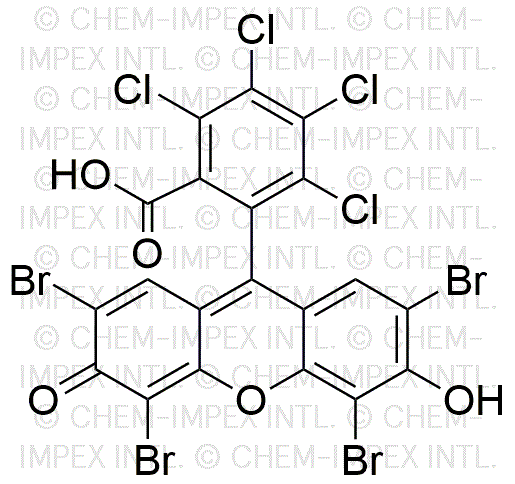2',4',5',7'-Tetrabromo-3,4,5,6-tetrachlorofluorescein is widely utilized in research focused on:
- Fluorescent Tracers: This compound is commonly used as a fluorescent tracer in biological and environmental studies, allowing researchers to visualize and track cellular processes or pollutant dispersion in water bodies.
- Analytical Chemistry: It serves as a reagent in analytical chemistry for detecting and quantifying various substances, enhancing the sensitivity of assays and improving accuracy in measurements.
- Histology and Microscopy: In histological applications, it is employed as a staining agent, providing clear contrast in microscopy, which is essential for studying tissue samples and cellular structures.
- Environmental Monitoring: The compound is used in environmental monitoring to assess the presence of heavy metals and other contaminants in soil and water, aiding in pollution control and remediation efforts.
- Research in Photonics: It plays a role in photonics research, particularly in developing new materials for optical devices, due to its unique fluorescent properties that can be tailored for specific applications.
Informations générales
Propriétés
Sécurité et réglementation
Applications
2',4',5',7'-Tetrabromo-3,4,5,6-tetrachlorofluorescein is widely utilized in research focused on:
- Fluorescent Tracers: This compound is commonly used as a fluorescent tracer in biological and environmental studies, allowing researchers to visualize and track cellular processes or pollutant dispersion in water bodies.
- Analytical Chemistry: It serves as a reagent in analytical chemistry for detecting and quantifying various substances, enhancing the sensitivity of assays and improving accuracy in measurements.
- Histology and Microscopy: In histological applications, it is employed as a staining agent, providing clear contrast in microscopy, which is essential for studying tissue samples and cellular structures.
- Environmental Monitoring: The compound is used in environmental monitoring to assess the presence of heavy metals and other contaminants in soil and water, aiding in pollution control and remediation efforts.
- Research in Photonics: It plays a role in photonics research, particularly in developing new materials for optical devices, due to its unique fluorescent properties that can be tailored for specific applications.
Documents
Fiches de données de sécurité (FDS)
La FDS fournit des informations de sécurité complètes sur la manipulation, le stockage et l’élimination du produit.
Spécifications du produit (PS)
Le PS fournit une description complète des propriétés du produit, notamment sa composition chimique, son état physique, sa pureté et les exigences de stockage. Il détaille également les plages de qualité acceptables et les applications prévues du produit.
Certificats d'analyse (COA)
Recherchez des certificats d'analyse (COA) en saisissant le numéro de lot du produit. Les numéros de lot et de lot se trouvent sur l'étiquette d'un produit, après les mots « Lot » ou « Lot de fabrication ».
Numéro de catalogue
Numéro de lot/série
Certificats d'origine (COO)
Ce certificat d'exploitation confirme le pays dans lequel le produit a été fabriqué, et détaille également les matériaux et composants utilisés et s'il est issu de sources naturelles, synthétiques ou autres sources spécifiques. Ce certificat peut être requis pour les douanes, le commerce et la conformité réglementaire.
Numéro de catalogue
Numéro de lot/série
Fiches de données de sécurité (FDS)
La FDS fournit des informations de sécurité complètes sur la manipulation, le stockage et l’élimination du produit.
DownloadSpécifications du produit (PS)
Le PS fournit une description complète des propriétés du produit, notamment sa composition chimique, son état physique, sa pureté et les exigences de stockage. Il détaille également les plages de qualité acceptables et les applications prévues du produit.
DownloadCertificats d'analyse (COA)
Recherchez des certificats d'analyse (COA) en saisissant le numéro de lot du produit. Les numéros de lot et de lot se trouvent sur l'étiquette d'un produit, après les mots « Lot » ou « Lot de fabrication ».
Numéro de catalogue
Numéro de lot/série
Certificats d'origine (COO)
Ce certificat d'exploitation confirme le pays dans lequel le produit a été fabriqué, et détaille également les matériaux et composants utilisés et s'il est issu de sources naturelles, synthétiques ou autres sources spécifiques. Ce certificat peut être requis pour les douanes, le commerce et la conformité réglementaire.


